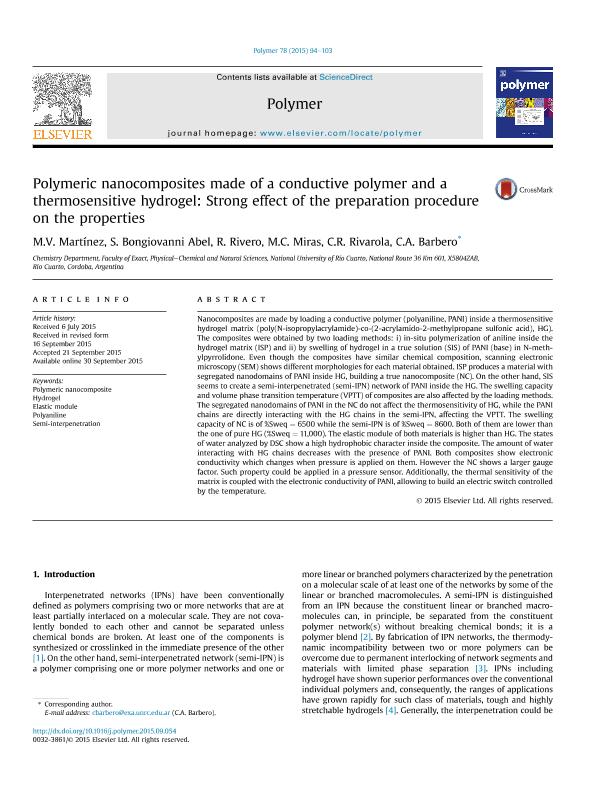Mostrar el registro sencillo del ítem
dc.contributor.author
Martinez, María Victoria

dc.contributor.author
Bongiovanni Abel, Silvestre Manuel

dc.contributor.author
Rivero, Rebeca Edith

dc.contributor.author
Miras, Maria Cristina

dc.contributor.author
Rivarola, Claudia Rosana

dc.contributor.author
Barbero, César Alfredo

dc.date.available
2019-02-07T16:00:08Z
dc.date.issued
2015-11
dc.identifier.citation
Martinez, María Victoria; Bongiovanni Abel, Silvestre Manuel; Rivero, Rebeca Edith; Miras, Maria Cristina; Rivarola, Claudia Rosana; et al.; Polymeric nanocomposites made of a conductive polymer and a thermosensitive hydrogel: Strong effect of the preparation procedure on the properties; Elsevier; Polymer; 78; 11-2015; 94-103
dc.identifier.issn
0032-3861
dc.identifier.uri
http://hdl.handle.net/11336/69630
dc.description.abstract
Nanocomposites are made by loading a conductive polymer (polyaniline, PANI) inside a thermosensitive hydrogel matrix (poly(N-isopropylacrylamide)-co-(2-acrylamido-2-methylpropane sulfonic acid), HG). The composites were obtained by two loading methods: i) in-situ polymerization of aniline inside the hydrogel matrix (ISP) and ii) by swelling of hydrogel in a true solution (SIS) of PANI (base) in N-methylpyrrolidone. Even though the composites have similar chemical composition, scanning electronic microscopy (SEM) shows different morphologies for each material obtained. ISP produces a material with segregated nanodomains of PANI inside HG, building a true nanocomposite (NC). On the other hand, SIS seems to create a semi-interpenetrated (semi-IPN) network of PANI inside the HG. The swelling capacity and volume phase transition temperature (VPTT) of composites are also affected by the loading methods. The segregated nanodomains of PANI in the NC do not affect the thermosensitivity of HG, while the PANI chains are directly interacting with the HG chains in the semi-IPN, affecting the VPTT. The swelling capacity of NC is of %Sweq = 6500 while the semi-IPN is of %Sweq = 8600. Both of them are lower than the one of pure HG (%Sweq = 11,000). The elastic module of both materials is higher than HG. The states of water analyzed by DSC show a high hydrophobic character inside the composite. The amount of water interacting with HG chains decreases with the presence of PANI. Both composites show electronic conductivity which changes when pressure is applied on them. However the NC shows a larger gauge factor. Such property could be applied in a pressure sensor. Additionally, the thermal sensitivity of the matrix is coupled with the electronic conductivity of PANI, allowing to build an electric switch controlled by the temperature.
dc.format
application/pdf
dc.language.iso
eng
dc.publisher
Elsevier

dc.rights
info:eu-repo/semantics/openAccess
dc.rights.uri
https://creativecommons.org/licenses/by-nc-nd/2.5/ar/
dc.subject
Elastic Module
dc.subject
Hydrogel
dc.subject
Polyaniline
dc.subject
Polymeric Nanocomposite
dc.subject
Semi-Interpenetration
dc.subject.classification
Otras Ciencias Químicas

dc.subject.classification
Ciencias Químicas

dc.subject.classification
CIENCIAS NATURALES Y EXACTAS

dc.title
Polymeric nanocomposites made of a conductive polymer and a thermosensitive hydrogel: Strong effect of the preparation procedure on the properties
dc.type
info:eu-repo/semantics/article
dc.type
info:ar-repo/semantics/artículo
dc.type
info:eu-repo/semantics/publishedVersion
dc.date.updated
2019-02-07T15:01:14Z
dc.journal.volume
78
dc.journal.pagination
94-103
dc.journal.pais
Países Bajos

dc.journal.ciudad
Amsterdam
dc.description.fil
Fil: Martinez, María Victoria. Universidad Nacional de Río Cuarto. Facultad de Ciencias Exactas Fisicoquímicas y Naturales. Departamento de Química; Argentina. Consejo Nacional de Investigaciones Científicas y Técnicas; Argentina
dc.description.fil
Fil: Bongiovanni Abel, Silvestre Manuel. Universidad Nacional de Río Cuarto. Facultad de Ciencias Exactas Fisicoquímicas y Naturales. Departamento de Química; Argentina. Consejo Nacional de Investigaciones Científicas y Técnicas; Argentina
dc.description.fil
Fil: Rivero, Rebeca Edith. Universidad Nacional de Río Cuarto. Facultad de Ciencias Exactas Fisicoquímicas y Naturales. Departamento de Química; Argentina. Consejo Nacional de Investigaciones Científicas y Técnicas; Argentina
dc.description.fil
Fil: Miras, Maria Cristina. Universidad Nacional de Río Cuarto. Facultad de Ciencias Exactas Fisicoquímicas y Naturales. Departamento de Química; Argentina
dc.description.fil
Fil: Rivarola, Claudia Rosana. Universidad Nacional de Río Cuarto. Facultad de Ciencias Exactas Fisicoquímicas y Naturales. Departamento de Química; Argentina. Consejo Nacional de Investigaciones Científicas y Técnicas; Argentina
dc.description.fil
Fil: Barbero, César Alfredo. Universidad Nacional de Río Cuarto. Facultad de Ciencias Exactas Fisicoquímicas y Naturales. Departamento de Química; Argentina. Consejo Nacional de Investigaciones Científicas y Técnicas; Argentina
dc.journal.title
Polymer

dc.relation.alternativeid
info:eu-repo/semantics/altIdentifier/doi/http://dx.doi.org/10.1016/j.polymer.2015.09.054
dc.relation.alternativeid
info:eu-repo/semantics/altIdentifier/url/https://www.sciencedirect.com/science/article/pii/S0032386115302597
Archivos asociados
